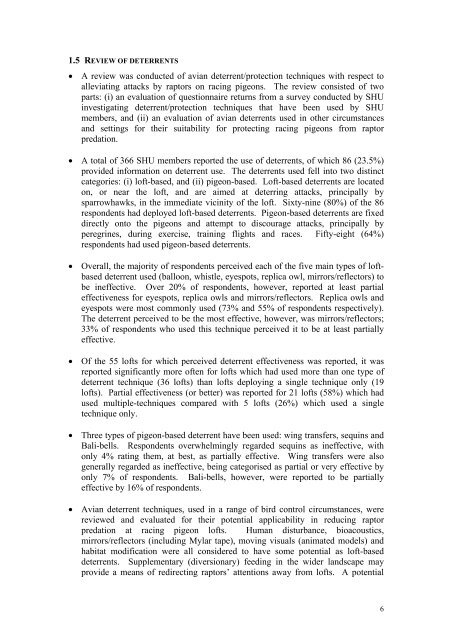RACING PIGEONS â IMPACT OF RAPTOR PREDATION
RACING PIGEONS â IMPACT OF RAPTOR PREDATION
RACING PIGEONS â IMPACT OF RAPTOR PREDATION
You also want an ePaper? Increase the reach of your titles
YUMPU automatically turns print PDFs into web optimized ePapers that Google loves.
1.5 REVIEW <strong>OF</strong> DETERRENTS<br />
• A review was conducted of avian deterrent/protection techniques with respect to<br />
alleviating attacks by raptors on racing pigeons. The review consisted of two<br />
parts: (i) an evaluation of questionnaire returns from a survey conducted by SHU<br />
investigating deterrent/protection techniques that have been used by SHU<br />
members, and (ii) an evaluation of avian deterrents used in other circumstances<br />
and settings for their suitability for protecting racing pigeons from raptor<br />
predation.<br />
• A total of 366 SHU members reported the use of deterrents, of which 86 (23.5%)<br />
provided information on deterrent use. The deterrents used fell into two distinct<br />
categories: (i) loft-based, and (ii) pigeon-based. Loft-based deterrents are located<br />
on, or near the loft, and are aimed at deterring attacks, principally by<br />
sparrowhawks, in the immediate vicinity of the loft. Sixty-nine (80%) of the 86<br />
respondents had deployed loft-based deterrents. Pigeon-based deterrents are fixed<br />
directly onto the pigeons and attempt to discourage attacks, principally by<br />
peregrines, during exercise, training flights and races. Fifty-eight (64%)<br />
respondents had used pigeon-based deterrents.<br />
• Overall, the majority of respondents perceived each of the five main types of loftbased<br />
deterrent used (balloon, whistle, eyespots, replica owl, mirrors/reflectors) to<br />
be ineffective. Over 20% of respondents, however, reported at least partial<br />
effectiveness for eyespots, replica owls and mirrors/reflectors. Replica owls and<br />
eyespots were most commonly used (73% and 55% of respondents respectively).<br />
The deterrent perceived to be the most effective, however, was mirrors/reflectors;<br />
33% of respondents who used this technique perceived it to be at least partially<br />
effective.<br />
• Of the 55 lofts for which perceived deterrent effectiveness was reported, it was<br />
reported significantly more often for lofts which had used more than one type of<br />
deterrent technique (36 lofts) than lofts deploying a single technique only (19<br />
lofts). Partial effectiveness (or better) was reported for 21 lofts (58%) which had<br />
used multiple-techniques compared with 5 lofts (26%) which used a single<br />
technique only.<br />
• Three types of pigeon-based deterrent have been used: wing transfers, sequins and<br />
Bali-bells. Respondents overwhelmingly regarded sequins as ineffective, with<br />
only 4% rating them, at best, as partially effective. Wing transfers were also<br />
generally regarded as ineffective, being categorised as partial or very effective by<br />
only 7% of respondents. Bali-bells, however, were reported to be partially<br />
effective by 16% of respondents.<br />
• Avian deterrent techniques, used in a range of bird control circumstances, were<br />
reviewed and evaluated for their potential applicability in reducing raptor<br />
predation at racing pigeon lofts. Human disturbance, bioacoustics,<br />
mirrors/reflectors (including Mylar tape), moving visuals (animated models) and<br />
habitat modification were all considered to have some potential as loft-based<br />
deterrents. Supplementary (diversionary) feeding in the wider landscape may<br />
provide a means of redirecting raptors’ attentions away from lofts. A potential<br />
6
















